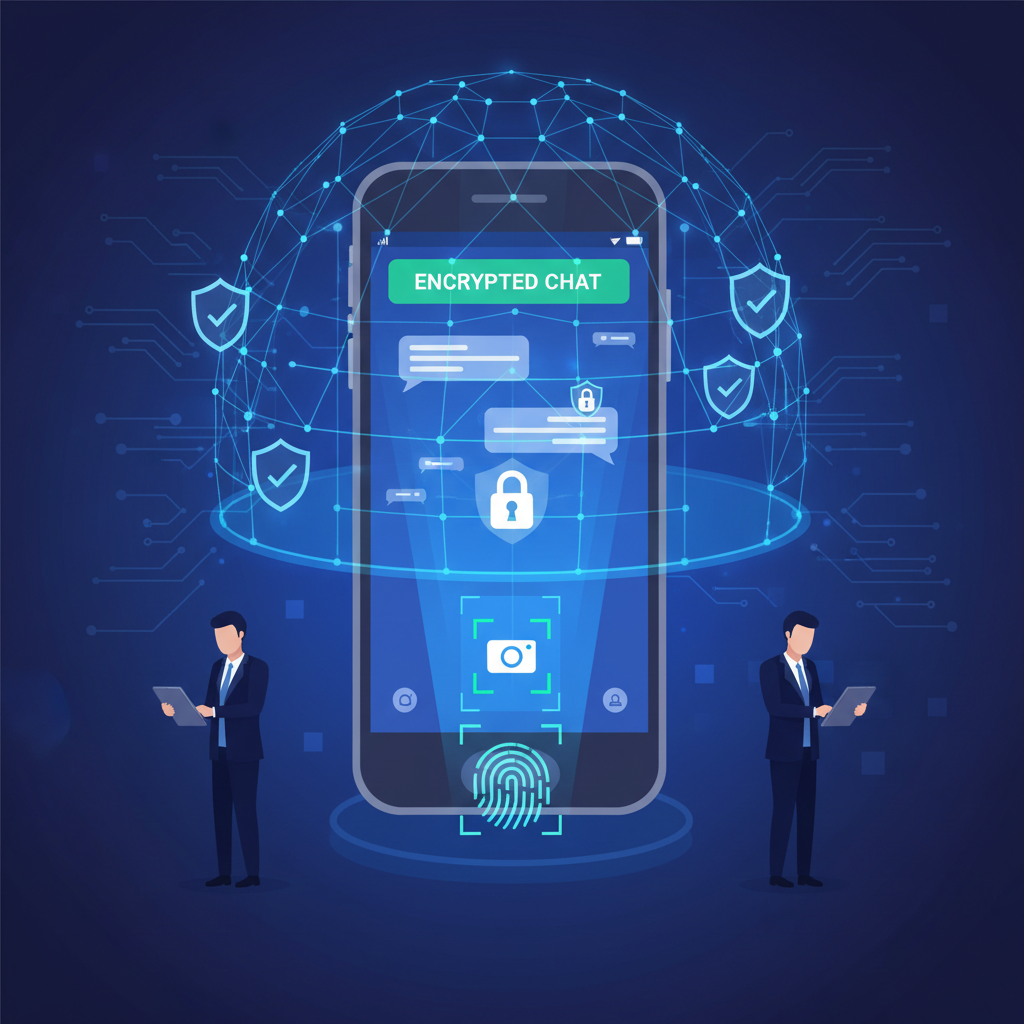The Salt Typhoon cyberattacks represent a pivotal moment for organisations in critical infrastructure, enterprise, and government sectors. These sophisticated intrusions into major telecommunications providers have exposed fundamental vulnerabilities in our communication infrastructure. In response, many organizations are turning to consumer messaging apps like WhatsApp, Signal, or Telegram as quick fixes for secure communications.
While these consumer apps offer better security than standard SMS or unencrypted email, they are not designed for—and cannot adequately protect—sensitive business, government, or critical infrastructure communications. Understanding why consumer apps fall short is essential for making informed security decisions.
The Consumer App Appeal (And Why It’s Misleading)
What Makes Consumer Apps Attractive
Consumer messaging apps have several appealing characteristics:
- Free or low-cost: No upfront licensing fees
- Familiar interface: Users already know how to use them
- End-to-end encryption: Messages are encrypted in transit
- Quick deployment: Download and start using immediately
- Cross-platform: Work on mobile and desktop
The Hidden Costs
What seems free often comes with significant hidden costs:
- Data as payment: Your metadata, contacts, and usage patterns are the product
- Limited control: No control over features, updates, or data handling
- Compliance gaps: May not meet regulatory requirements
- Security incidents: Breaches expose organizational communications
- Reputation damage: Using consumer tools suggests amateur security posture
Critical Gaps in Consumer Messaging Apps
While message content may be encrypted, consumer apps collect extensive metadata:
WhatsApp (Meta/Facebook):
- Phone numbers of all contacts
- Device information and identifiers
- User activity patterns
- Group membership information
- Profile photos and status messages
- Payment and transaction data
- IP addresses and location data
This metadata reveals:
- Who communicates with whom
- Frequency and timing of communications
- Social and professional networks
- Location and travel patterns
- Organizational structure
For adversaries, metadata often provides more valuable intelligence than message content.
2. Centralized Control and Single Points of Failure
Consumer apps rely on centralized infrastructure controlled by the provider:
Vulnerabilities:
- Provider holds encryption keys for cloud backups
- Centralized servers are high-value targets
- Government access requests can compromise accounts
- Provider policies can change without notice
- Service outages affect all users simultaneously
- No redundancy or business continuity guarantees
Real Examples:
- WhatsApp outages affecting billions
- Government-mandated backdoors in some countries
- Providers forced to share data with authorities
- Policy changes affecting encryption or privacy
3. Limited Enterprise Controls
Consumer apps lack essential enterprise security features:
Missing Capabilities:
- No centralized administration
- Limited user provisioning/de-provisioning
- No policy enforcement mechanisms
- Insufficient audit logging
- No data loss prevention (DLP)
- Limited retention and archiving
- No integration with identity management
- Minimal compliance reporting
These gaps create serious security and compliance risks.
4. Cloud Backup Vulnerabilities
Many consumer apps encourage cloud backups for convenience:
Security Issues:
- Backups often not end-to-end encrypted
- Stored on third-party cloud providers
- Subject to cloud provider vulnerabilities
- Accessible via account recovery mechanisms
- May include all historical messages
- Difficult to fully delete
Result: End-to-end encryption becomes meaningless if backups are exposed.
5. Account Security Weaknesses
Consumer apps typically use phone numbers as primary identifiers:
Vulnerabilities:
- SIM swapping attacks transfer account access
- Phone number recycling gives access to new owner
- SMS-based 2FA can be intercepted
- Account recovery often weakly secured
- No hardware token support
- Limited protection against credential stuffing
Impact: Attackers can gain complete account access, including message history.
6. Compliance and Regulatory Issues
Consumer apps often cannot meet regulatory requirements:
HIPAA (Healthcare):
- Insufficient Business Associate Agreements (BAA)
- Inadequate access controls
- Incomplete audit trails
- Retention policy conflicts
- No evidence preservation capabilities
GDPR (Privacy):
- Excessive metadata collection
- Data residency concerns
- Limited data subject rights implementation
- Unclear data processing agreements
- Third-party data sharing
SOX (Financial):
- Inadequate record retention
- No preservation for legal holds
- Insufficient access controls
- Limited audit capabilities
FedRAMP/ITAR (Government):
- No certification for government use
- Data sovereignty issues
- Insufficient security controls
- No support for classified communications
Industry-Specific:
- Legal privilege concerns
- Attorney-client communications
- Financial advice documentation
- Medical record transmission
7. Data Sovereignty and Jurisdiction
Consumer apps raise complex jurisdictional issues:
Concerns:
- Data stored in unknown locations
- Subject to foreign government access laws
- No control over data residency
- Unclear legal protections
- Conflicting international regulations
Implications:
- Violation of data localization requirements
- Exposure to foreign intelligence collection
- Legal liability in multiple jurisdictions
- Competitive intelligence risks
8. Feature Limitations for Business Use
Consumer apps lack critical business features:
Communication:
- No integration with business systems
- Limited conference call capabilities
- No screen sharing for confidential discussions
- Insufficient user directory management
- No role-based access controls
Security:
- Can’t disable screenshots
- No remote wipe of specific conversations
- Limited device management
- No geofencing or location restrictions
- Insufficient access logging
Management:
- No bulk user provisioning
- Limited group management
- No organizational structure support
- Insufficient reporting and analytics
- No API for automation
Real-World Consequences
Case Study: Healthcare Provider HIPAA Violation
A hospital system allowed staff to use WhatsApp for patient coordination:
Result:
- $1.5 million HIPAA fine
- Required comprehensive security overhaul
- Mandatory staff retraining
- Multi-year monitoring agreement
- Significant reputation damage
Issue: WhatsApp’s terms explicitly exclude healthcare use without proper BAA.
Case Study: Legal Firm Privilege Waiver
Law firm used Signal for client communications:
Result:
- Court ruled attorney-client privilege potentially waived
- Forced disclosure of communications
- Malpractice claim filed
- Client relationship damaged
- Subsequent clients lost
Issue: Consumer app didn’t meet professional communication standards.
Case Study: Corporate Espionage
Executive team used Telegram for M&A discussions:
Result:
- Confidential information leaked to competitors
- Deal terms became public
- Stock manipulation concerns
- SEC investigation
- $50 million in deal value lost
Issue: Inadequate security controls and audit trail.
Case Study: Government Contractor Violation
Defense contractor used WhatsApp for project coordination:
Result:
- Contract termination
- ITAR violation charges
- Debarment from future contracts
- Criminal investigation
- Company dissolved
Issue: Failed to meet government security requirements.
When Consumer Apps Might Be Acceptable
Consumer messaging apps may be appropriate for:
- General team coordination
- Non-sensitive social communications
- Public information sharing
- Initial contact before moving to secure channels
- Personal use by employees (not for work)
Critical Caveat: Organizations should explicitly prohibit use of consumer apps for any sensitive business communications and provide approved alternatives.
The Enterprise Alternative: What’s Required
Essential Enterprise Features
1. True Zero-Knowledge Architecture
- Provider cannot access message content
- No metadata collection beyond what’s essential
- End-to-end encryption with no backdoors
- Client-controlled encryption keys
2. Comprehensive Administrative Controls
- Centralized user management
- Role-based access control
- Policy enforcement mechanisms
- Device management integration
- Audit logging and reporting
3. Compliance and Governance
- Industry-specific compliance support
- Data retention and archiving
- Legal hold capabilities
- Evidence preservation
- Audit trails meeting regulatory standards
4. Data Sovereignty
- On-premises deployment options
- Control over data location
- No third-party dependencies
- Air-gapped deployment capability
- Complete infrastructure control
5. Security Features
- Post-quantum encryption
- Hardware token support
- Advanced authentication
- Remote security management
- Secure deletion and wiping
6. Business Integration
- Enterprise system integration
- Identity management integration
- SSO support
- API for automation
- Workflow integration
Cellcrypt: Purpose-Built for Enterprise Security
Cellcrypt addresses every gap in consumer messaging apps:
Security Architecture
Zero-Knowledge Design:
- Cellcrypt cannot access your messages
- No metadata collection
- End-to-end encryption for all communications
- Client-controlled encryption keys
Post-Quantum Protection:
- Dual-layer PQ encryption
- NIST-standardized algorithms
- Future-proof security
- Protection against harvest-now-decrypt-later threats
Military-Grade Encryption:
- NATO approved
- Government certified
- Independently audited
- Proven in classified environments
Enterprise Controls
Administration:
- Centralized user management
- Policy enforcement
- Device provisioning and de-provisioning
- Role-based access control
- Group and organization management
Compliance:
- HIPAA-compliant
- GDPR-ready
- SOX-compatible
- FedRAMP pathway
- Industry-specific certifications
Audit and Reporting:
- Comprehensive audit logs
- Compliance reporting
- Legal hold support
- Evidence preservation
- Chain of custody
Deployment Flexibility
On-Premises:
- Complete data control
- Air-gapped deployment
- Custom security policies
- Integration with existing infrastructure
Cloud:
- Rapid deployment
- Managed infrastructure
- Automatic updates
- Scalable architecture
Hybrid:
- Combine on-prem and cloud
- Gradual migration path
- Maximum flexibility
- Best of both approaches
Advanced Features
Communications:
- Encrypted voice and video calls
- Secure messaging and group chat
- Encrypted file sharing
- Screen sharing with encryption
- Conference calls
Security:
- Perfect forward secrecy
- Secure deletion
- Screenshot prevention
- Remote wipe
- Geofencing
Business Integration:
- Active Directory integration
- SSO support
- API for custom integration
- Mobile device management (MDM)
- Enterprise app stores
Migration Strategy
Transitioning from Consumer to Enterprise Messaging
Phase 1: Assessment (Weeks 1-2)
- Audit current messaging usage
- Identify sensitive communications
- Determine compliance requirements
- Map user groups and needs
Phase 2: Planning (Weeks 3-4)
- Define security policies
- Plan deployment architecture
- Prepare user training
- Establish success metrics
Phase 3: Pilot (Weeks 5-8)
- Deploy to small user group
- Gather feedback
- Refine policies and training
- Validate compliance
Phase 4: Rollout (Weeks 9-16)
- Gradual expansion to all users
- Ongoing training and support
- Monitor adoption
- Address issues
Phase 5: Enforcement (Week 17+)
- Disable consumer app access
- Enforce policies
- Regular audits
- Continuous improvement
Conclusion
Consumer messaging apps are not enterprise security solutions. While they provide better protection than standard SMS or unencrypted email, they lack the security controls, compliance features, and administrative capabilities that organizations need to protect sensitive communications.
The risks of using consumer apps for business communications include:
- Metadata exposure and analysis
- Compliance violations and fines
- Legal privilege concerns
- Data sovereignty issues
- Insufficient audit trails
- Limited administrative control
- Single points of failure
- Unclear legal protections
Organizations in critical infrastructure, enterprise, government, healthcare, legal, and financial sectors cannot afford these gaps. The consequences of a breach or compliance violation far exceed the cost of implementing proper enterprise secure communications.
Cellcrypt provides the comprehensive security, enterprise controls, and compliance features that consumer apps cannot deliver. Purpose-built for sensitive communications, Cellcrypt combines military-grade encryption with the flexibility and features that organizations need.
Don’t let the convenience of consumer apps compromise your organization’s security. Implement enterprise-grade secure communications designed for the threats you actually face.
Get Started with Cellcrypt | Compare Consumer Apps vs Enterprise Solutions



